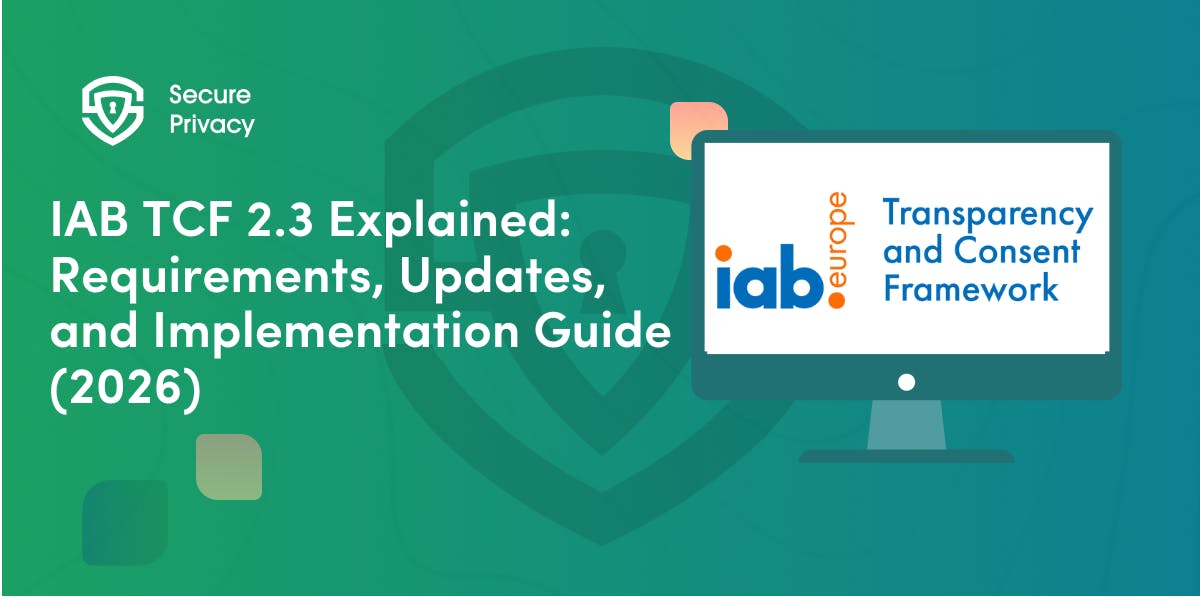Financial Data Consent Trends: Biometric Data and Dynamic Permissions in 2025
The financial sector’s rapid adoption of biometric technologies and dynamic consent frameworks is transforming how institutions manage customer data. As of March 2025, 87% of global banks now use biometric authentication, while regulators intensify scrutiny of consent practices. This deep dive explores the intersection of biometric data usage, evolving consent requirements, and the shift toward real-time, dynamic permissions in finance.
The financial sector's rapid adoption of biometric technologies and dynamic consent frameworks is transforming how institutions manage customer data. As of March 2025, 87% of global banks now use biometric authentication, while regulators intensify scrutiny of consent practices. This evolving landscape creates both challenges and opportunities for financial institutions navigating the intersection of security, convenience, and privacy.
Are your consent practices keeping pace with these rapid changes? As biometric authentication becomes the norm rather than the exception, understanding the latest trends in permissions management has become essential for regulatory compliance and customer trust.
The Rise of Biometric Data in Finance
Biometric authentication has become a cornerstone of modern banking, driven by demand for frictionless security and fraud prevention. This technology shift is reshaping how financial institutions approach customer identification and transaction security.
Multi-Modal Biometric Systems
Leading financial institutions have moved beyond single-factor biometric authentication to embrace comprehensive multi-modal approaches. Banks like DBS and HSBC now combine facial recognition, voice authentication, and behavioral biometrics (keystroke dynamics) to create layered security that's both stronger and more user-friendly.
The impact of these systems has been substantial, reducing synthetic ID fraud by 63% and account takeover attempts by 41% according to Number Analytics' 2025 report. This dramatic improvement in security outcomes has accelerated adoption across the industry, even among institutions initially hesitant about biometric technologies.
Contactless Authentication
The pandemic-era shift toward contactless experiences has become permanent, with palm-vein scanning and facial recognition ATMs projected to grow 300% by 2026 according to HID Global. This transformation eliminates the need for physical cards while maintaining robust security through unique biological identifiers.
Regulatory developments are further accelerating this trend. China's 2025 facial recognition laws mandate "least intrusive methods," pushing financial institutions throughout APAC markets to adopt contactless technologies that balance security with privacy considerations.
Behavioral Biometrics for Fraud Prevention
Perhaps the most significant development is the rise of behavioral biometrics – systems that analyze how users interact with devices rather than static physical characteristics. These AI-powered systems monitor mouse movements, typing speed, and navigation patterns to detect anomalies that might indicate fraud.
A European bank demonstrated the effectiveness of this approach, reducing payment fraud by 52% using dynamic behavioral profiling, according to Corporate Compliance Insights. This success has prompted widespread adoption of similar systems, creating a new frontier in financial security that requires fresh approaches to consent management.
Regulatory Landscape: Consent in the Biometric Era
As biometric adoption accelerates, regulators worldwide have responded with increasingly stringent requirements for securing explicit consent and providing granular control over sensitive biological data.
Explicit Consent Requirements
General privacy frameworks like GDPR and CCPA have established baseline requirements for biometric data, mandating opt-in consent for collection with strict rules on storage. Most jurisdictions now limit retention to six months unless users actively provide renewed consent – a requirement that has forced financial institutions to implement regular reconsent workflows.
China's 2025 Facial Recognition Laws have introduced even more specific restrictions, prohibiting biometric use in private spaces such as hotel rooms and requiring "clear justification" for deployment alongside real-time alternatives like ID cards. These requirements have established new global benchmarks that many institutions are adopting even outside Chinese markets.
Dynamic Permissions Frameworks
Static, one-time consent mechanisms are rapidly becoming obsolete. Today's regulatory environment demands dynamic permissions systems that allow users to adjust consent preferences in real time – for example, revoking face scan access while retaining fingerprint authentication.
Platforms like Secure Privacy's Consent Orchestrator now enable sophisticated control mechanisms, including time-bound permissions (e.g., "Use my voiceprint for 30 days") and context-aware controls that block biometric sharing with specific third parties such as lenders. These granular controls help financial institutions maintain compliance while giving customers unprecedented autonomy over their biometric identifiers.
Transparency Mandates
Transparency requirements have evolved beyond simple disclosures to mandate comprehensive information about biometric data management. China's model requires businesses to disclose storage duration, encryption standards, and revocation procedures upfront before collecting any biometric identifiers.
The EU's proposed 2025 GDPR amendments go further, requiring "quantum-safe encryption" labels for biometric databases. This requirement acknowledges the long-term sensitivity of biometric data and the need for future-proof security measures that can withstand emerging computational threats.
Security Challenges & Solutions
The sensitive nature of biometric data creates unique security challenges that financial institutions must address through sophisticated technical measures.
Quantum Decryption Risks
With quantum computing advancing rapidly, today's encryption standards may become vulnerable to decryption attempts targeting valuable biometric databases. Forward-thinking institutions are implementing post-quantum lattice-based encryption like NIST's CRYSTALS-Kyber to protect biometric templates against future quantum attacks.
Singapore's DBS Bank demonstrates this approach in action, using quantum-resistant consent chains to secure over 15 million biometric records in alignment with MAS 2025 guidelines. This proactive strategy ensures that today's biometric implementations remain secure even as computational capabilities advance.
Biometric Spoofing
As authentication systems have become more sophisticated, so have attempts to defeat them through spoofing. Financial institutions are countering these threats with liveness detection via 3D depth mapping combined with AI anomaly checks that can distinguish between genuine biometric presentations and sophisticated forgeries.
These multi-layered defenses have become essential as deepfakes and other synthetic media become more convincing. The most effective implementations combine multiple verification factors to ensure that even if one biometric element is compromised, the overall authentication remains secure.
Consent Data Harvesting
Beyond protecting the biometric data itself, institutions must safeguard the consent records that legitimize their collection and use. Tokenization of biometric templates through irreversible hashing has emerged as the industry standard, ensuring that even if consent records are compromised, the underlying biometric data remains protected.
Ethical Considerations & Consumer Trust
Beyond regulatory compliance, financial institutions face important ethical considerations in their use of biometric technologies. Building and maintaining consumer trust requires thoughtful approaches to user interface design, algorithmic fairness, and ongoing education.
Avoiding Dark Patterns
Regulatory bodies have taken strong action against manipulative consent practices in biometric implementation. The FTC's 2024 $14.8 million fine against a neobank for "coercive" biometric opt-ins sent shockwaves through the industry, prompting widespread user interface reforms to ensure genuine, informed consent.
Leading institutions have responded with transparent, user-friendly approaches to biometric permissions. Revolut's "Privacy Dashboard" exemplifies industry best practices, allowing users to toggle biometric permissions for specific services—enabling face ID for logins while disabling it for loan approvals, for instance. This granular control empowers users while demonstrating the institution's commitment to ethical data practices.
Bias Mitigation
Algorithmic bias remains a significant concern in biometric implementations. Recent research from MIT (2024) indicates that facial recognition error rates remain 4.7 times higher for darker-skinned women, raising serious equity concerns as these technologies become essential for financial access.
The EU's 2025 Ethical AI Certification addresses these concerns by requiring annual audits of biometric algorithms. Financial institutions seeking certification must demonstrate ongoing monitoring and improvement of their systems to ensure fair performance across demographic groups. This regulatory push has accelerated industry efforts to develop more inclusive biometric technologies.
Consumer Education
Effective consent requires informed decision-making, which many institutions now facilitate through dedicated educational initiatives. Mastercard's "Biometric Choice" program leads the field, educating users on data usage via in-app micro-learning modules. This approach has boosted opt-in rates by 33%, demonstrating that transparency and education benefit both consumers and institutions.
These education efforts extend beyond explaining how technologies work to clarifying what rights consumers have regarding their biometric data. The most effective programs combine technical information with practical guidance on managing permissions and exercising control over personal information.
The Future: 2026 and Beyond
Several emerging trends will shape the evolution of biometric consent in finance over the coming years, potentially transforming the relationship between institutions and customer data.
Decentralized Biometric Ownership
Blockchain-based "biometric wallets" represent perhaps the most radical shift on the horizon. Ripple's 2025 pilot program demonstrates how these systems could allow users to store and lease face or fingerprint data via smart contracts, fundamentally altering the power dynamic between individuals and institutions.
This decentralized approach gives consumers unprecedented control over their biometric identifiers while providing institutions with secure, auditable access when authorized. The model addresses many current consent challenges by placing ownership clearly with the individual rather than the institution.
Emotional AI Consent
As biometric technologies advance, they're increasingly capable of detecting emotional states through voice stress analysis and facial micro-expressions. Banks like ING are experimenting with these capabilities for loan risk assessments, creating a need for new "emotive data" consent categories.
This frontier raises profound questions about what constitutes biometric data and how granular consent should become. Institutions pioneering these technologies must develop thoughtful frameworks that acknowledge the sensitivity of emotional information while demonstrating clear value to consumers who share it.
Regulatory Convergence
The current fragmented regulatory landscape creates compliance challenges for global financial institutions. Industry analysts predict that G7 nations will standardize biometric consent rules by 2026, inspired by China's CAC framework and GDPR's dynamic permission mandates.
This convergence would simplify compliance while establishing clearer expectations for both institutions and consumers. Forward-thinking financial organizations are already aligning their consent frameworks with the strictest existing requirements, anticipating this harmonization and positioning themselves for seamless adaptation.
Key Takeaways for Financial Institutions
As biometric authentication becomes ubiquitous in finance, several strategic imperatives emerge for institutions navigating this complex landscape:
First, adopt multi-layered consent approaches that pair biometrics with fallback authentication methods. This strategy not only complies with China-style "least intrusive" rules but also accommodates users who cannot or choose not to use biometric authentication, ensuring inclusive access to financial services.
Second, invest in quantum-ready technology for both biometric storage and consent records. With 78% of breaches now targeting legacy biometric systems according to IBM's 2025 report, future-proofing your security infrastructure has become a business imperative rather than merely a compliance concern.
Finally, recognize the potential to transform trust into revenue. Accenture's 2025 research reveals that 69% of customers willingly pay premium fees for banks with transparent biometric controls. This finding suggests that robust, ethical consent practices can become a competitive differentiator rather than simply a cost center.
The global biometrics market is projected to reach $82.9 billion by 2027, with dynamic consent tools capturing 40% of sector spending according to Number Analytics. This growth underscores the strategic importance of developing sophisticated, ethical approaches to biometric consent—not just for compliance, but as a fundamental component of customer relationships in the digital age.
By embracing transparent consent practices, implementing robust security measures, and providing meaningful control to customers, financial institutions can navigate the biometric revolution while building the trust essential for long-term success in an increasingly data-driven industry.
Get Started For Free with the
#1 Cookie Consent Platform.
No credit card required

What is Cookie Consent? A Quick 2026-Ready Glance
Your website loads. Cookies track users. But without proper cookie consent, you're violating GDPR — risking fines up to €20 million or 4% of global revenue. Cookie consent is the legally required mechanism by which websites obtain explicit user approval before deploying non-essential tracking technologies. This requirement stems from GDPR Article 4(11) and the ePrivacy Directive, mandating that consent must be freely given, specific, informed, and unambiguous.
- Legal & News

DSAR Tools Explained: Best Software for Automating Privacy Requests
You're drowning in data subject access requests. Manual searches through dozens of systems miss regulatory deadlines and expose organizations to fines starting at $2,500 per violation. The solution? DSAR tools — purpose-built software that automates the entire process of responding to data subject access requests, from intake to delivery.
- Legal & News

IAB TCF 2.3 Explained: Requirements, Updates, and Implementation Guide (2026)
Your ad revenue dropped 40% overnight. Google stopped bidding on your inventory. Your DSP partners flagged your traffic as non-compliant. The culprit? An outdated TCF 2.2 consent string after the February 2026 enforcement deadline.
- Legal & News
- Cookie Consent

